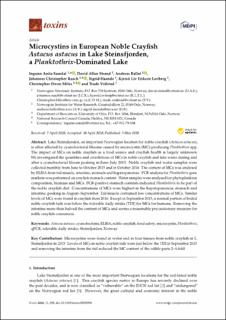Microcystins in European Noble Crayfish Astacus astacus in Lake Steinsfjorden, a Planktothrix-Dominated Lake
Samdal, Ingunn Anita; Strand, David; Ballot, Andreas; Rusch, Johannes; Haande, Sigrid; Løvberg, Kjersti Eriksen; Miles, Christopher Owen; Vrålstad, Trude
Peer reviewed, Journal article
Published version
Permanent lenke
https://hdl.handle.net/11250/2660624Utgivelsesdato
2020Metadata
Vis full innførselSamlinger
- Publikasjoner fra Cristin - NIVA [2149]
- Scientific publications [1172]
Sammendrag
Lake Steinsfjorden, an important Norwegian location for noble crayfish (Astacus astacus), is often affected by cyanobacterial blooms caused by microcystin (MC)-producing Planktothrix spp. The impact of MCs on noble crayfish as a food source and crayfish health is largely unknown. We investigated the quantities and correlations of MCs in noble crayfish and lake water during and after a cyanobacterial bloom peaking in June–July 2015. Noble crayfish and water samples were collected monthly from June to October 2015 and in October 2016. The content of MCs was analysed by ELISA from tail muscle, intestine, stomach and hepatopancreas. PCR analysis for Planktothrix gene markers was performed on crayfish stomach content. Water samples were analysed for phytoplankton composition, biomass and MCs. PCR-positive stomach contents indicated Planktothrix to be part of the noble crayfish diet. Concentrations of MCs were highest in the hepatopancreas, stomach and intestine, peaking in August–September. Tail muscle contained low concentrations of MCs. Similar levels of MCs were found in crayfish from 2016. Except in September 2015, a normal portion of boiled noble crayfish tails was below the tolerable daily intake (TDI) for MCs for humans. Removing the intestine more than halved the content of MCs and seems a reasonable precautionary measure for noble crayfish consumers.

